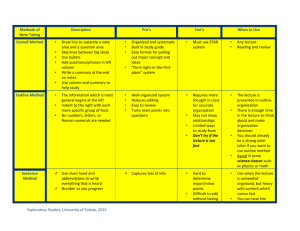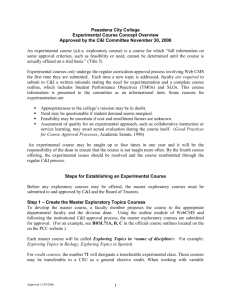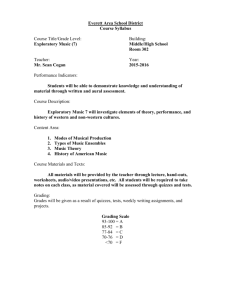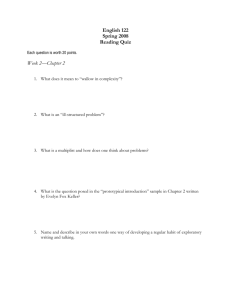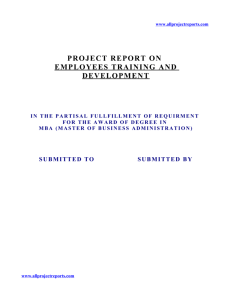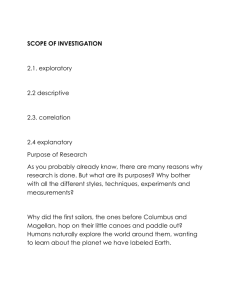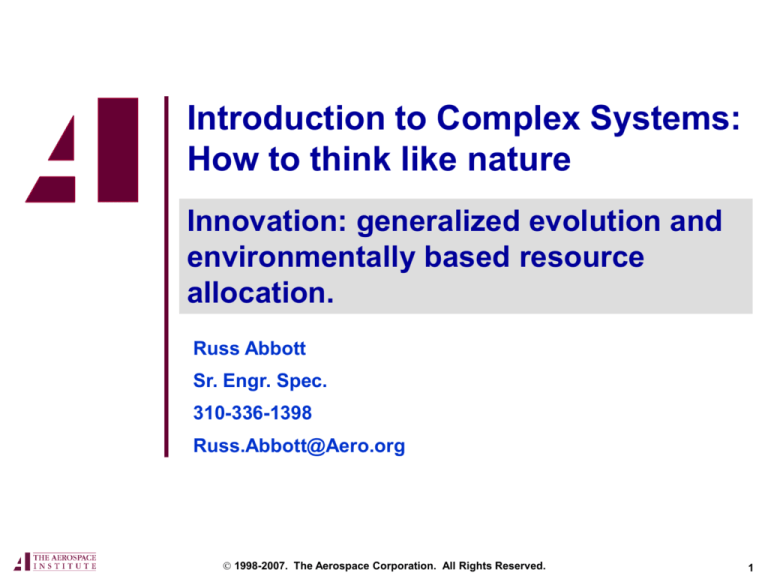
Introduction to Complex Systems:
How to think like nature
Innovation: generalized evolution and
environmentally based resource
allocation.
Russ Abbott
Sr. Engr. Spec.
310-336-1398
Russ.Abbott@Aero.org
1998-2007. The Aerospace Corporation. All Rights Reserved.
1
Innovative environments
Net-centricity and the GIG
• Inspired by the web and the internet
• Goal: to bring the creativity of the web and the internet
to the DoD
Other innovative environments
• Market economies
• Biological evolution
• The scientific and technological research process
What do innovative environments have in common?
How can organizations become innovative?
2
The innovative process: exploratory behavior
If I were to give an award for the single best idea anyone has ever had, I'd
give it to Darwin, ahead of Newton and Einstein and everyone else.
In a single stroke, the idea of evolution by natural selection unifies the
realm of life, meaning, and purpose with the realm of space and time,
cause and effect, mechanism and physical law. Daniel Dennett, Darwin's Dangerous Idea
Innovation, including human creativity, is always the result of an
evolutionary process.
• Generate new variants (e.g., ideas)—typically by combining and
modifying existing ones.
– This is a random process in nature.
The easy part!
– But random or not isn’t the point.
– The point is to generate lots of possibilities, to explore the landscape.
• (Select and) exploit the good ones
– Allow/enable the good ones to flourish.
The hard part!
3
Exploratory behavior in nature
• Evolution.
• E. Coli navigation.
• The immune system.
• Termite nest building.
• Ant and bee foraging.
• Building out the circulatory and nervous systems.
4
Mental exploratory behavior in non-human animals
Not long ago I watched [a grey squirrel] eyeing the [bird] feeder ... It
studied the situation long and hard from one side of the deck, then
from the other. It climbed up on the railing to study the situation
from there, first from one side, then from the other side, and then
from underneath. It eyed the screen on the door that goes out to the
deck. Finally it made a try. Starting from a run along the railing, it
leapt and ricocheted off the screen toward the feeder but missed.
Once again it surveyed the situation from various angles, and finally
succeeded by hitting the screen a little higher up, then hanging on
tight [to the feeder]. I hadn't the heart to shoo it away!
What was going on in that squirrel's head as it sat up on its
haunches, studying and studying from this angle and that? What
was going on, I suspect, was a sort of trial and error in perception. It
was trying to see a way up, trying to see an affordance. Similarly …
before crossing a stream on scattered rocks, it may take you a while
to see a good way to cross without wetting your feet. … This form of
rationality seems to be common to humans and, I imagine, many
other animals as well.
Ruth Garrett Millikan “Styles of Rationality” http://www.ucc.uconn.edu/%7Ewwwphil/ratam.pdf
5
Exploratory behavior in humans and society
• As processes carried out by individuals
– Individual mental trial and error exploration.
– Modeling and simulation.
• As processes carried out by groups
– Market economies. (A speeded up form of evolution.)
– The scientific and technological research process.
• These give us enormous leverage and speed-up over
traditional evolution.
It’s better to let one’s hypotheses die in one’s stead.
—Karl Popper, source uncertain.
M. Nudds and S. Hurley eds. (2006) Rationality in Animals, (Oxford: Oxford University Press);
Introduction: http://www.cogs.indiana.edu/spackled/2006-Kacelnik%20Rationality.pdf.
6
Exploratory behavior: groups and individuals
• Exploratory behavior typically requires autonomous individuals to
do the exploration.
• Much exploratory behavior is wasted effort.
– Successful group exploratory behavior typically requires multiple,
loosely coordinated, i.e., autonomous, individuals.
• One may hit the jackpot while the others drill dry holes.
• For a group to benefit from the discoveries of individuals, there
must be mechanisms that bring those discoveries back to the
group and allow them to take root.
– Mechanisms to internalize successful/promising discoveries must
be built into a group’s process.
Recall ant foraging and pheromone following.
– This frequently requires “creative destruction,” which may be more
difficult to accept—especially if it’s your job that is being destroyed.
– Markets are how we integrate creative destruction into society.
It’s amazing how well we have tamed destruction.
It is now an accepted part of our normal processes.
Joseph Schumpeter,
Capitalism, Socialism, and Democracy
7
How does this apply to organizations?
To ensure innovation:
Creation and trial
• Encourage the prolific generation and trial of new
ideas.
Establish the successful variants
• Allow new ideas to flourish or wither based on
how well they do—rather than political reasons.
Sounds simple doesn’t it?
8
Innovation in various environments
New ideas
aren’t the
problem.
Biological
evolution
Entrepreneur
Bureaucracy
Trying them out
Initial funding
Prospect of
failure
Capitalism in
the small.
Nature always
experiments.
Most are failures,
which means
death. (But no
choice given.)
Little needed
for an Internet
experiment.
Perhaps some
embarrassment,
time, money; not
much more.
Proposals,
competition,
forms, etc.
Approvals
Getting
good ideas
Establishment
established
None.
Bottom-up
resource
allocation
defines
success.
Few.
Entrepreneur
wants rewards.
Bottom-up
resource
allocation.
When 100%
Managers have
Mission Success
Far too
other priorities.
is the group goal,
many.
Top-down
who wants a
We save ourselves resource
failure in his/her by spin-doctoring
personnel file? and benign neglect allocation.
9
Exploratory behavior: asymmetric warfare
• It is the nature of complex systems
and evolutionary processes that
conflicts become asymmetric.
• No matter how well armored one is …
• there will always be chinks in the
armor, … and something will
inevitably find those chinks.
• The something that finds those
chinks will by definition be
asymmetric since it attacks the
chinks and not the armor.
10
Exploratory behavior: like water finding a way down hill
Microbes attempting to get into your body must first get past your
skin and mucous membranes, which not only pose a physical barrier
but are rich in scavenger cells and IgA antibodies.
Next, they must elude a series of nonspecific defenses—and
substances that attack all invaders regardless of the epitopes they
carry. These include patrolling phagocytes, granulocytes, NK cells,
and complement.
Infectious agents that get past these nonspecific barriers must finally
confront specific weapons tailored just for them. These include both
antibodies and cytotoxic T cells.
From a tutorial on the immune system from the National Cancer Institute.
Quite a challenge! We are very well defended. But we still get sick!
Some “invaders” will make it past these defenses. The problem is not
even that some get through, it’s that they exploit their success.
How do they find the open pathways? It’s not
“invaders” vs. “defenders.”
Through (evolutionary) exploratory behavior, if
there is a way, some will inevitably find it.
Innovation is the
(disruptive) invader
not the defender.
Innovative organizations make that inevitability work in their favor.
11
Exploratory behavior: recall evolutionary processes
• How can the human genome, with fewer than 25,000 genes
– fill in all the details of the circulatory and nervous systems?
– produce a brain with trillions of cells and synaptic connections?
• Cell growth followed by species-specific die-off produces webbing
in duck feet and bat wings but not in human fingers.
• Military strategy of “probing for weakness.”
• Ant and bee foraging: group is a perceptual organ for individuals.
• Scientific research.
• Corporate strategy of seeking (or creating) marketing niches.
The general mechanism is:
• Prolifically generate a wide range of possibilities
• Establish connections to new sources of value in the environment.
Mechanism
generation
Function
explore
Purpose
use result
Bottom up
12
“Garages and laboratories, workbenches, and scribbled
napkins are filled with brilliant ideas unmatched with
determination, resources, and market sensibilities.”
Jack Russo, Silicon Valley intellectual-property lawyer.
• In 1999, when Nathan Myhrvold left Microsoft (formerly CTO; brilliant, but
he missed the importance of the web) he set himself an unusual goal.
• He wanted to see whether the kind of insight that leads to invention could
be engineered.
• He formed a company called Intellectual Ventures.
• He raised hundreds of millions of dollars.
• He hired the smartest people he knew.
• It was not a venture-capital firm.
– Venture capitalists fund insights. They let the magical process that generates
new ideas take its course, and then they jump in.
• Myhrvold wanted to make insights—to come up with ideas, patent them,
and then license them to interested companies.
Malcolm Gladwell (May 12, 2008) “In the Air,” The New Yorker, http://www.newyorker.com/reporting/2008/05/12/080512fa_fact_gladwell
Matt Richtel (March 30, 2008) “Edison ...Wasn’t He the Guy Who Invented Everything?,” New York Times,
http://www.nytimes.com/2008/03/30/weekinreview/30richtel.html
13
Planned invention?
• When Myhrvold started out, his expectations were modest.
• Although he wanted insights like Alexander Graham Bell’s, Bell was
clearly one in a million, a genius who went on to have ideas in an
extraordinary number of areas—sound recording, flight, lasers,
tetrahedral construction, and hydrofoil boats, to name a few.
• Invention has its own algorithm—some combination of genius, obsession,
serendipity, and epiphany. How can you plan for that?
• The original expectation was that I.V. would file a hundred patents a year.
• It’s filing five hundred a year and has a backlog of three thousand ideas.
• It just licensed off a cluster of patents for $80,000,000.
• Its ideas are not trivial.
–
–
–
–
Improved jet engines
New techniques for making microchips
A way to custom-tailor the mesh “sleeve” used to repair aneurysms
Automatic, battery-powered glasses, with a tiny video camera that reads the
image off the retina and adjusts the fluid-filled lenses accordingly, up to ten
times a second.
Malcolm Gladwell (May 12, 2008) “In the Air,” The New Yorker, http://www.newyorker.com/reporting/2008/05/12/080512fa_fact_gladwell
14
The history of science is full
of ideas that several people
had at the same time
• Newton and Leibniz: calculus.
• No less than nine claimants: the telescope.
• At least six different inventors: the thermometer.
• Three mathematicians: invention of decimal fractions.
• Charles Darwin and Alfred Russel Wallace: evolution.
• Elisha Gray and Alexander Graham Bell: the telephone.
• John Napier, Henry Briggs, and Joost Bürgi: logarithms.
• Charles Cros and Louis Ducos du Hauron: color photography.
• Galileo, Scheiner, Fabricius, and Harriott: discovery of sunspots.
• Joseph Priestley and Carl Wilhelm Scheele: discovery of oxygen.
• Several individuals in England and in America: typewriting machines.
• Fulton, Jouffroy, Rumsey, Stevens, and Symmington: the steamboat.
• Édouard-Léon Scott de Martinville and Thomas Edison: the phonograph.
• Mayer, Joule, Thomson, Colding, and Helmholz: formulation of the conservation of energy.
W. F. Ogburn & D. S. Thomas (March 1922) “Are inventions inevitable?” Political Science Quartly, 37, 83-98.
Malcolm Gladwell (May 12, 2008) “In the Air,” The New Yorker, http://www.newyorker.com/reporting/2008/05/12/080512fa_fact_gladwell
Matt Richtel (March 30, 2008) “Edison ...Wasn’t He the Guy Who Invented Everything?,” New York Times, http://www.nytimes.com/2008/03/30/weekinreview/30richtel.html
15
The genius is not a unique source of insight.
He is merely an efficient source of insight.
A scientific genius is not a person who does
what no one else can do; he or she is someone
who does what it takes many others to do.
Consider Kelvin:
• At least 32 “multiple” discoveries, involving 30 other scientists.
• Some, like Stokes, Green, Helmholtz, Cavendish, Clausius,
Poincaré, Rayleigh, themselves men of undeniable genius.
• Others, like Hankel, Pfaff, Homer Lane, Varley, and Lamé,
men of talent but not of the highest order.
• Each of these discoveries was destined to find expression
without Kelvin.
• Kelvin’s stature as a genius remains undiminished. It required
many others to duplicate these 32 discoveries.
William Thomson,
1st Baron Kelvin
Malcolm Gladwell (May 12, 2008) “In the Air,” The New Yorker, http://www.newyorker.com/reporting/2008/05/12/080512fa_fact_gladwell
Robert K. Merton (1961) “Singletons and Multiples in Scientific Discovery: A Chapter in the Sociology of Science,”
Proceedings of the American Philosophical Society 105: 470–86
16
Practical innovation
• Although innovation has become a management
buzzword, a significant amount of practical progress
has been made in understanding how to make
organizations innovative.
– Hamel, Gary and Bill Breen (October, 2007) The Future of
Management, Harvard Business School Press.
– Skarzynski, Peter and Rowan Gibson (March 2008)
Innovation to the Core: a blueprint for transforming how your
company innovates, Harvard Business School Press.
• Hamel and Skarzynski, are founders of Strategos
(http://www.strategos.com/), a consulting company
that specializes in innovation.
17
Has an organization institutionalized innovation?
Hamel: ask employees these questions
•
How have you been equipped to be an innovator? What training have
you received? What tools have you been supplied with?
•
Do you have access to an innovation coach or mentor? Is there an
innovation expert who will help you develop your breakout idea?
•
How easy is it for you to get access to experimental funding? How
long would it take you to get a few thousand dollars in seed money?
How many levels of bureaucracy would you have to go through?
•
Is innovation a formal part of your job description? Does your
compensation depend in part on your innovation performance?
•
Do your organization’s management processes—budgeting, planning,
staffing, etc.—support or hinder your work as an innovator?
18
Skarzynski: an innovation “architecture”
•
An innovation pipeline for managing and opportunities
•
A core set of people trained in the processes of innovation
•
A systematic process for generating and managing strategic insights
•
The right evaluative criteria at every stage of the development process
to prevent potentially valuable ideas from being killed off prematurely
•
Ideas that are sufficiently radical to deliver breakthrough performance
•
Mechanisms for rapidly reallocating resources behind new opportunities
•
Mechanisms to manage growth opportunities with different timescales
and risk profiles
•
Metrics to measure innovation performance
•
Linkages between innovation and management compensation
•
A self-sustaining enterprise capability and a tangible core value
19
Simplified model of successful organisms/organizations
• Lower levels discover opportunities through exploratory behavior.
– New initiatives often grow from the “edges,” where perception occurs.
– Constrained by “rules of engagement,” which protect them from harm.
– Must be possible for initiatives to originate at all levels—even the top.
• Higher/broader levels provide perspective, impose constraints,
shape direction, and add or withhold resources as events develop.
– They do not primarily issue commands.
• This is primarily a bottom-up model of resource allocation.
– Decisions about increasingly significant commitments are made at
increasingly higher/broader levels. If the entire organism/organization
commits, becomes an entity-level goal.
• The top-level organism/organizational goal should be to stay
healthy and to build skills, resources, and capabilities which can
be recruited/applied/committed when needed.
Just what your mother always told you: eat right, exercise,
get plenty of sleep, study hard, practice, and save money.
20
C2: management in the military
• There is no “commander’s intent” in nature or in the market.
• But there is something like commander’s intent in entities.
– Biological organisms: survive, eat, reproduce.
– Businesses: survive and make money: execute current strategy, find
new (profitable) products/services/markets.
– Science: survive, get funding, discover and publish.
• Open-ended and internally focused: stay healthy.
– Different from external missions: accomplish X.
– Primary externally focused mission: maintain an environment in
which one can survive—and preferably flourish.
• Our military is intentionally mission driven—where the missions are
determined by civilian authority.
• We don’t want our military to take the initiative to find new missions
for itself.
• What kinds of initiatives does it make sense for the military to take?
– Initiatives that further already agreed upon missions—or derived
missions. I.e. internal initiatives that make it more effective at doing
what it is charged to do.
– It isn’t clear how success can be made self-defining in the same way
as making money or reproducing is self-defining. Need a way to
aggregate resources/success bottom-up.
21
Backups
22
Ensuring quality: markets vs. centralized control
• Markets ensure a reasonably high level of quality by
letting many variants appear and selecting the good ones.
– To do this requires
• the ability to recognize quality when one sees it
• means to generate lots of variants
• the luxury of allowing low quality items to come into being
and then be rejected. (Doesn’t work if low quality kills.)
– If these pertain, quality is (relatively) easy—although there
will always be fraud, free-riders, and counterfeiters.
• Centralized control ensures quality by rigid oversight.
– To do this requires that
• one know in advance how to produce quality and
• the means to ensure that the knowledge is applied.
– This is much harder.
23
Evolution and Markets
• All the mechanism we have seen are controlled evolution.
– Markets are evolution with initiative. (How would you define initiative?)
• The ability to act on one’s own. I.e., control over a source of energy that is
devoted to generating and apply variants.
– Nature has neither money or trading in goods or liquidity.
• Markets enable creative destruction without violence.
– For the most part, competition is for resources and not head-to-head
conflict. Competitors are rivals rather than adversaries. Cannot attack
the other directly.
• The bottom line is competition for resources, not conquest.
• But advertising and other forms of marketing and mass influence
attempts to influence how resources are allocated.
• So do attempts by entrenched interests to shape the environment, e.g.,
by regulations.
24
Designs in various environments
Recorded as
Internet
Software
Created by
How
instantiated
All
bottom-up
Established
Programmers
Self-instantiating
By users
By peer review
Scientific
knowledge
Publications
Scientists
The publication
is the
instantiation
Market
economy
Trade secrets
Product
developers
Entrepreneurial
manufacturing
By consumers
Biological
evolution
DNA
Combination
and mutation
Reproduction
Whether it finds
a niche
Implicit designs
Construction,
combination
and mutation
Implementation
of a level of
abstraction
Whether it finds
a niche
Entities:
nature’s
memes
25


